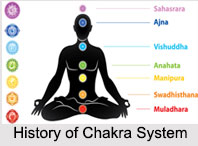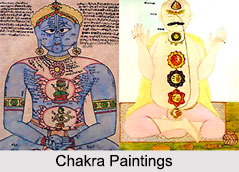 Chakras are inextricably linked with the science and practice of yoga. The origin of yoga and earliest mention of the chakras goes back to the Vedas. Upanishad mentioned the chakras as psychic centres of consciousness in the Yoga Upanishads and later in the Yoga Sutras of Patanjali.
Chakras are inextricably linked with the science and practice of yoga. The origin of yoga and earliest mention of the chakras goes back to the Vedas. Upanishad mentioned the chakras as psychic centres of consciousness in the Yoga Upanishads and later in the Yoga Sutras of Patanjali.
It was in the Tantric tradition that the chakras and Kundalini came to be an integral part of yoga philosophy. Tantrism regards the body as a sacred temple for the consciousness within. The word "Tantra" literally means "loom" and denotes a weaving of disparate threads into a tapestry of wholeness. Thus, the Chakra System, coming out of Tantric tradition, weaves the polarities of spirit and matter, mind and body, masculine and feminine, Heaven and Earth, into a single philosophy of many philosophical strands, reaching even back to the oral tradition that preceded the Vedas.
Several Texts on Chakra System
 Apart from the "Sat Chakra Nirupana" and the "Padaka Panchaka" written in the 10th Century, there is also another 10th Century text called the "Gorakshashatakam" which gives instructions for meditating on the chakras. These texts form the basis of the understanding of Chakra Theory today.
Apart from the "Sat Chakra Nirupana" and the "Padaka Panchaka" written in the 10th Century, there is also another 10th Century text called the "Gorakshashatakam" which gives instructions for meditating on the chakras. These texts form the basis of the understanding of Chakra Theory today.
Seven Chakras of Body
In these traditions, there are seven basic chakras that exist within the subtle body, interpenetrating the physical body. The subtle body is the non-physical psychic body that is superimposed on the physical bodies. It can be measured as electromagnetic force fields within and around all living creatures. In yoga psychology, the subtle body is divided into five sheaths of varying refinement in the subtle body, called koshas. At the core of the body, the subtle field appears as spinning disks or chakras. The chakras are the psychic generators of the auric field. The aura itself is the meeting point between the core patterns generated by the chakras and the influence of the external word.
These seven chakras are located near the seven major nerve ganglia that emanate from the spinal column. There are two minor chakras mentioned in the ancient texts, the "Soma Chakra", located just above the third eye, and the "Anandakanda Lotus", which contains the Celestial Wishing Tree or Kalpataru of the Heart Chakra. Some esoteric systems propose nine or twelve chakras, while other traditions, such as Vajrayana Buddhism, describe only five centres. Since a chakra is literally a vortex of energy, there is no limit to their number. However, the original seven master chakras form a profound and elegant system. Mastering the first seven chakras can easily take a lifetime.




















